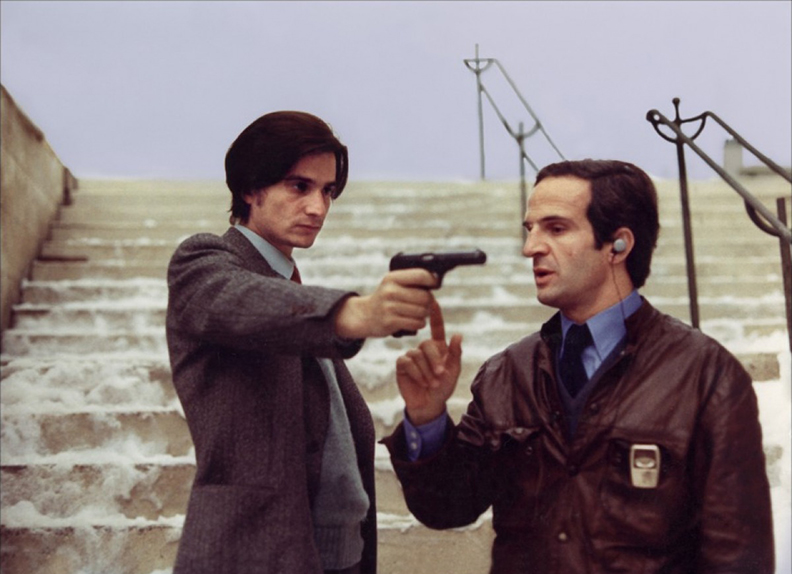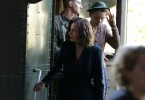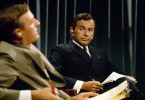Day for Night
Director: François Truffaut
Spine #769
(Blu-ray/DVD)
It’s almost become cliché to attribute artists as constantly battling an uneven flow from their creative wellspring. Yet, if one has ever created, it is plain to see that this is the frustrating, but rewarding, truth faced when rummaging through the corridors of the mind. Somewhere along this struggle, someone had the bright idea to turn it into the art, and suddenly not having an idea became an idea to explore in itself. Filmmakers are no stranger to this concept, often embracing their stagnation with unique contemplations on what it means to create. Such classics as Federico Fellini’s 8½ and Charlie Kaufman’s Synecdoche, New York stand as pillars of excellence while exploring the conflict of reaching that creative excellence. Released in 1973, Day for Night is an early example of the treasures that can be dug out of referencing one’s own creative bout.
The plot is straightforward, as lives of its cast and crew are examined on the set of a movie called Meet Pamela. Ferrand, the director, grapples with the daily anxiety of shooting a film: finding clever tricks to pull out of a scene, meeting deadlines expected by the studio, and, foremost, the emotions of his actors. On set, there’s a manchild who reacts poorly when his girlfriend leaves him, a woman who has recently recovered from a nervous breakdown, a calm-and-collected silver fox, and an alcoholic mother who is battling the grief of her son’s imminent death. These players, in tandem with the set crew, offer humorous encounters, melodrama, and some noteworthy expounding on love, life, and film.
Day for Night‘s central aspect, and its highest praise, comes from believably recreating the inner workings of the filming process. Its opening scene exemplifies this best: An aerial shot captures a plaza bustling with a wide range of characters, until we hear, “Cut!” as the director urges the scene to restart. The camera pulls back, revealing such behind-the-scenes roles as camera operators and lighting and sound technicians, giving credence to the notion that film, at its core, is an illusion. Another scene involves getting a cat to drink milk from a serving tray, which proves a frustrating task. But through patience, trial and error, and eventually switching out cats, the scene finally goes as planned. The divulged illusion exemplifies an oft-forgotten truth about art: that it’s not about magic, but having the perseverance to achieve a vision.
One of the film’s more interesting details is that it’s fictional director is also its actual director, Francois Truffaut, whose narration and on-screen commentary serve to teach and uncover the realities of being a director. At the start, he encompasses the job in one sentence, describing a director as “somebody who is constantly asked questions.” Later on, he categorizes filming into three simple stages: the beginning, the midpoint, and the end. The beginning is where the most conflict is encountered; the midpoint is where you reflect on the successes and failures of the beginning; and the end is where those reflections help you improve and invest the most into the film. Delectable tidbits like these give Day for Night a lecturing quality, albeit charmingly delivered by one of cinema’s great auteurs.
If there is a single question asked, it’s if work is more important than personal life, and a wide range of answers of given through the characters. The actors, for the most part, have difficulty balancing the two, as their breakdowns, dressing room lockups and attempted escapes make clear. Juxtaposing them is the crew, who find meaning in the stressful environment of shooting a film, with one crewmember pointing out, “I’d drop a guy for a film. I’d never drop a film for a guy!” As the anchor, the director represents the median ground best, always being reliable, emotionally intact, and ready to aid his team. Still, like all truthful pursuits, this is left open-ended for the audience to interpret.
Day for Night is necessary viewing for those who like to uncover the nitty-gritty details of the process of creation. It also remains a relevant addition, or introduction, to the career of Truffaut, who is remembered as a vital member of France’s rich cinematic history, specifically the French New Wave. If anything, it should endow a few lessons on filmmaking and invite rumination on the role of their craft within the context of their personal life.





